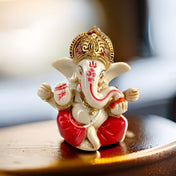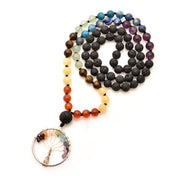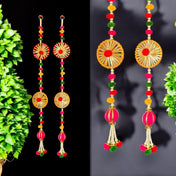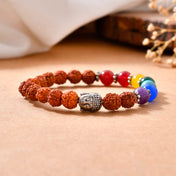Introduction
The tradition of Lumba Rakhi: Tie a Bond of Love with Your Sister-in-Law celebrates a unique and heartwarming connection that goes beyond the brother-sister relationship. Rooted deeply in Marwari culture, this special festival honors the sister-in-law, known as lumba, by tying a vibrant Rakhi on her wrist. This act symbolizes a bond of love, respect, and protection, nurturing family ties and extending the spirit of Raksha Bandhan within extended families.
In Indian households, particularly among Marwaris, the Lumba Rakhi holds immense cultural significance. It acknowledges the sister-in-law’s role as an essential thread in family unity, strengthening relationships that transcend bloodlines. The ritual is a beautiful reminder that bonds forged through marriage are equally cherished and celebrated.
This article is tailored specifically for the US audience, many of whom live far from their roots but wish to keep cultural traditions alive across continents. Readers can expect to discover:
- The origins and symbolism behind Lumba Rakhi
- Its spiritual and emotional dimensions
- Exquisite handcrafted designs like personalized rakhi cards or cartoon rakhi for brothers
- Practical tips for celebrating this tradition authentically in a multicultural setting
Whether you are reconnecting with your heritage or introducing these customs to new generations, this guide invites you to embrace the warmth and richness of Lumba Rakhi. To make this celebration even more special, consider gifting unique items such as a rakhi gift hamper with Indian sweets or a personalized letter name rakhi that adds a personal touch to your festivities.

The Beautiful Tradition of Lumba Rakhi
The Lumba Rakhi tradition is a cherished custom primarily rooted in the Marwari community, celebrated during the festival of Raksha Bandhan. Its origins trace back centuries, symbolizing the affectionate bond between a brother and his sister-in-law. Unlike the conventional rakhi tied by sisters on their brothers’ wrists, the Lumba Rakhi is tied specifically to the bride's bangles or wrist by her sister-in-law, marking a unique extension of familial love and respect.
Origins and History
Historically, this tradition evolved in Rajasthan and other parts of North India where marital relationships hold deep cultural significance. The word “Lumba” refers to the traditional bangle worn by married women in these regions. Tying a Lumba Rakhi is not just an act of festivity but also an acknowledgment of the sister-in-law’s new role within her husband’s family. This practice strengthens bonds beyond blood relations, fostering harmony among extended family members.
Symbolic Significance
Each time a sister-in-law ties a Lumba Rakhi, it conveys protection, care, and blessings. The ritual symbolizes an emotional promise—a vow to support each other through life’s challenges. It celebrates unity while recognizing individual roles within the family structure. This rakhi carries more than thread; it binds hearts with trust and affection.
Fostering Unity Across Distances
For Indian families living in the United States, where relatives may be separated by states or even coasts, the Lumba Rakhi tradition becomes especially meaningful. It acts as a bridge connecting family members across distances, reinforcing relationships that might otherwise weaken due to physical separation. Through this beautiful custom, families nurture their shared heritage while adapting to new environments.
This inclusive gesture warmly embraces all sisters-in-law, inviting them into a circle of mutual respect and love—an invaluable thread weaving together diverse family dynamics in modern times. The Lumba Rakhi tradition thus serves as both cultural preservation and emotional connection in contemporary multicultural settings.
To celebrate this beautiful tradition, you can consider purchasing unique lumba rakhis such as this peacock lumba designer rakhi or this leaf lumba designer rakhi. These rakhis not only symbolize love and protection but also serve as exquisite gifts for your brother and sister-in-law during this special occasion.
Embracing Cultural Values through Lumba Rakhi
The tradition of tying a Lumba Rakhi beautifully embodies the spirit of inclusivity, compassion, and equality. While it is deeply rooted in Indian culture, its essence transcends geographical and cultural boundaries by promoting a universal sisterhood. Through this simple yet profound act, the bond between sisters-in-law transforms into a symbol of mutual respect and affection that resonates with women everywhere.
Spiritual Dimensions Beyond Rituals
Lumba Rakhi is more than just a ceremonial thread; it holds spiritual significance that nurtures emotional well-being and harmony within families. The tying ceremony symbolizes protection, blessings, and the strengthening of positive energies between women who share life’s joys and challenges. This connection fosters a nurturing environment where compassion flows naturally, encouraging empathy and understanding.
“The thread tied during Lumba Rakhi carries prayers for safety, prosperity, and happiness—not only for the wearer but for the entire family.”
Countering Toxic Environments with Empowerment
In today’s world, women still face various forms of social and emotional toxicity. The Lumba Rakhi tradition acts as a gentle yet powerful counterforce to such negativity. By honoring sister-in-law relationships through this ritual, families create spaces where women feel valued and supported. This practice encourages open communication, respect for individuality, and solidarity among female family members.
- Reinforces emotional support networks.
- Encourages equality within extended families.
- Cultivates an atmosphere where women uplift one another.
This nurturing tradition holds particular relevance in multicultural settings such as the United States, where diverse family dynamics can sometimes lead to isolation or misunderstandings. Lumba Rakhi becomes a beacon promoting unity and love amidst complexity.
The values embedded in this ceremony reflect universal truths — that every woman deserves to be cherished and empowered regardless of her role or background within the family structure. Each knot tied on the wrist is a promise to uphold these ideals with sincerity and warmth.

Not only does this tradition strengthen familial bonds, but it also opens up avenues for thoughtful gifting. For instance, while celebrating Raksha Bandhan with your brother, you might consider exploring unique rakhi gift hampers that blend traditional elements with modern aesthetics. These hampers often include an intricately designed rakhi along with other symbolic items like roli and chawal.
Similarly, if you're looking for something specific for your brother this Raksha Bandhan, you can find several options such as raksha bandhan rakhi bracelets or designer rakhis that are perfect for this occasion.
Moreover, when it comes to celebrating the bond with your sister-in-law through the Lumba Rakhi tradition, there are beautiful Lumba lumbar rakhi pair hampers available which serve as an excellent way to honor this special relationship.
Craftsmanship and Symbolism Behind Lumba Rakhis
Lumba Rakhis captivate with their colorful designs that echo the vibrant spirit of Raksha Bandhan. These feminine adornments are not merely decorative; they carry deep cultural resonance through every stitch and embellishment. The artistry involved transforms each Lumba Rakhi into a small masterpiece, reflecting joy, protection, and affection.
Materials and Techniques
- Embroidery: Intricate threadwork forms the backbone of many Lumba Rakhis. Patterns range from traditional motifs to contemporary interpretations, stitched meticulously to symbolize the delicate bond shared with a sister-in-law.
- Sequins and Mirror Work: Tiny mirrors and shimmering sequins catch the light during festivities, symbolizing clarity, reflection, and positive energy. This sparkling detail enhances the festive aura around the ceremony.
- Beads and Charms: Strings of beads and carefully chosen charms add texture and meaning. Beads often represent unity and continuity, while charms can carry personalized blessings or auspicious symbols like peacocks or lotus flowers.
Each material is selected not only for beauty but also for its symbolic significance. For example:
- Mirrors are believed to ward off negative energies.
- Embroidery patterns sometimes depict protective symbols or floral designs signifying growth and harmony.
- Charms may convey wishes for health, happiness, or prosperity.
Unique Expressions of Love
No two Lumba Rakhis are exactly alike. Artisans pour their passion into crafting each piece, ensuring the Rakhi becomes a unique token of affection. The blend of traditional techniques with contemporary aesthetics makes every Lumba Rakhi a meaningful gift that honors both heritage and personal connection.
The concept of a Lumba Rakhi goes beyond a ritual; it is an expression woven through color, fabric, and symbolism—each thread strengthening ties across generations. This bond is not limited to sisters-in-law alone; it extends to brothers as well. For instance, you can find unique rakhi for brother round charm raksha bandhan which serve as perfect gifts for brothers during this festival.
Moreover, the significance of Lumba Rakhis is further amplified by their inclusion in various collections such as the Evil Eye Rakhi Collection, which offers rakhis made with diverse materials like beads, gold plating, and stones—all carrying their own symbolic meanings.
In addition to these traditional offerings, there are also options for bulk rakhi greeting cards which could be an excellent way to spread joy among multiple siblings or cousins during the festive season.
As we celebrate this beautiful festival of love and protection, we can also enhance our home decor with items like happy rakhi banners, which add a festive touch to any celebration.
Finally, let's not forget about the younger members of our family who also partake in this joyous occasion. Special kids rakhi hampers make for delightful gifts that will surely bring smiles to their faces as they join in on the festivities!
Celebrating the Tying Ceremony: A Joyous Occasion
The tying of the Lumba Rakhi is not just a ritual; it is a celebration of love, unity, and family bonds. As the ceremony unfolds, it brings forth a joyous atmosphere that resonates with laughter, affection, and heartfelt emotions. The air is filled with the sound of joy as sisters-in-law come together to strengthen their relationship through this beautiful tradition.
In addition to the emotional richness of the occasion, traditional foods and sweets play a significant role in enhancing the experience. These delicacies not only add flavor to the celebration but also carry cultural significance that connects individuals to their roots. From delectable sweets like gulab jamun and barfi to savory treats like samosas and pakoras, every bite tells a story of tradition and togetherness.
To immerse yourself fully in the spirit of the Lumba Rakhi ceremony, you can prepare these dishes at home or explore local Indian stores in the US that offer authentic ingredients and ready-made treats. This culinary aspect adds a sensory dimension to the event, engaging taste buds along with emotions and creating lasting memories.
The combination of joyous festivities, heartfelt moments, and flavorful delights makes the tying ceremony a truly special occasion that captures the essence of familial love and cultural heritage. By embracing these traditions wholeheartedly, individuals can experience the beauty of Indian customs even across oceans and continents.
Moreover, incorporating unique elements into this celebration can further enhance its significance. For instance, using a small Ganesh Rakhi for your brother or bhaiya bhabhi can add a traditional touch to this joyous occasion. Such handmade designer rakhi sets are not just beautiful but also carry deep cultural significance.
Additionally, decorative items like peacock haldi kumkum holders can be used during the ceremony. These traditional roli chawal/rice holders are perfect for Indian festivals and can be an excellent addition to your pooja thali or housewarming gifts.
By embracing these traditions wholeheartedly and incorporating such unique elements into your celebrations, you can create an unforgettable Lumba Rakhi ceremony that beautifully captures the essence of familial love and cultural heritage.
Extending Love and Protection: The Role of Older Women in Lumba Rakhi Tradition
The Lumba Rakhi tradition is enriched by the heartfelt involvement of older women in the family, who play a pivotal role in nurturing bonds across generations. This custom encompasses more than just tying a decorative thread; it represents a profound care and protection promise extended by elder women to their younger female relatives.

In many households, mothers-in-law and elder sisters-in-law ceremoniously tie Lumba Rakhis on younger sisters-in-law or even nieces, symbolizing an enduring commitment to safeguard their well-being. This act transcends ritualistic formality, becoming an affectionate vow that the wearer will be supported, cherished, and protected within the familial fold.
Such practices hold special resonance in multicultural environments like the United States, where Indian families may be geographically dispersed. The care and protection promise serves as a reassuring thread that maintains emotional closeness despite physical distances. It strengthens ties between generations and affirms the value placed on female relationships within extended families.
Older women often accompany the tying ceremony with blessings and words of wisdom, underscoring the importance of unity, respect, and mutual support. This nurturing tradition fosters a sense of security for younger women entering new family dynamics through marriage or relocation. It also empowers them by embedding a cultural legacy that honors their place within the family structure.
The symbolic nature of this exchange reflects broader Indian values where elder women are seen as custodians of heritage and well-being. Their participation ensures that Lumba Rakhi remains a living tradition—adapting gracefully while preserving its original spirit of love and protection.
By actively involving older women in the celebration, families create intergenerational moments filled with warmth and meaning. Such rituals encourage continuity, ensuring that every sister-in-law feels valued not only as part of the household but as someone embraced wholeheartedly with promises of care woven into every colorful thread.
Bringing Lumba Rakhis Closer to You: Online Availability for US Audience
Celebrating the tradition of Lumba Rakhi: Tie a Bond of Love with Your Sister-in-Law has become more accessible than ever, especially for Indian families residing in the US. Distance from loved ones no longer means missing out on this meaningful ritual.
Online purchase options for US audience offer a seamless way to obtain authentic Lumba Rakhis that carry the vibrant spirit and cultural depth of this custom. Several specialized e-commerce platforms provide:
- A wide variety of handcrafted Lumba Rakhis reflecting traditional designs and modern aesthetics
- Options to personalize rakhis, adding a special touch to your gift
- Detailed product descriptions explaining the symbolism behind each rakhi
Delivery networks span across India and extend globally, ensuring timely arrival of these precious tokens right at your doorstep in the US. This convenience supports families who live thousands of miles apart but wish to maintain their cultural ties and celebrate together.
By bridging geographical gaps through technology, online availability reinforces the emotional connection inherent in tying a Lumba Rakhi. It enables you to uphold family traditions while embracing contemporary lifestyles, making every celebration heartfelt and complete.
LoveNspire: Promoting Cultural Expressions through Handmade Products like Lumba Rakhis
LoveNspire stands as a beacon of cultural appreciation and celebration, aiming to enrich lives through the beauty and significance of handmade products like Lumba Rakhis. By curating a collection that honors traditional craftsmanship and artistry, LoveNspire offers a unique way to connect with cultural heritage in a modern world.
Connection to Tradition
The values upheld by LoveNspire perfectly align with the essence of the Lumba Rakhi tradition. Just as Lumba Rakhis symbolize love, care, and protection between sisters-in-law, LoveNspire's handmade products carry the same spirit of fostering meaningful connections and spreading joy through cultural expressions.
Through their dedication to preserving cultural art forms and promoting authentic craftsmanship, LoveNspire not only provides exquisite products but also serves as a platform for individuals to engage with and appreciate diverse traditions. Their offerings include not just traditional Lumba Rakhis but also contemporary and personalized Rakhi options, making it possible for everyone to find something that resonates with their unique style while still honoring the rich traditions associated with these handmade products.
Conclusion
The act of tying a Lumba Rakhi serves as a symbol of love and protection towards your sister-in-law. It is a reminder to reflect on the importance of maintaining and nurturing this unique relationship, even when physically apart.
The Lumba Rakhi ceremony holds traditions and values that are significant in strengthening familial bonds. By cherishing these customs, we can invite love and connection into our lives.
Cultural celebrations like Lumba Rakhi have the power to foster connections and spread love. They remind us of the beauty in diversity and the importance of coming together as a family.
In essence, by honoring the tradition of tying a Lumba Rakhi, you not only express your affection for your sister-in-law but also uphold the cherished bond that unites you both in love and respect. Additionally, consider exploring other beautiful rakhi options that can further enhance these familial ties.




















